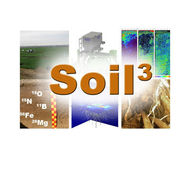Iron isotope fractionation in soil and graminaceous crops after 100 years of liming in the long‐term agricultural experimental site at Berlin‐Dahlem, Germany (2021.0)
Wu B., Wang Y., Berns A., Schweitzer K., Bauke S., Bol R., Amelung W.
European Journal of Soil Science, 72 (1), 289-299
Abstract
Sustainable arable cropping relies on repeated liming. Yet, the associated increase in soil pH can reduce the availability of iron (Fe) to plants. We hypothesized that repeated liming, but not pedogenic processes such as lessivage (i.e., translocation of clay particles), alters the Fe cycle in Luvisol soil, thereby affecting Fe isotope composition in soils and crops. Hence, we analysed Fe concentrations and isotope compositions in soil profiles and winter rye from the long‐term agricultural experimental site in Berlin‐Dahlem, Germany, where a controlled liming trial with three field replicates per treatment has been conducted on Albic Luvisols since 1923. Heterogeneity in subsoil was observed at this site for Fe concentration but not for Fe isotope composition. Lessivage had not affected Fe isotope composition in the soil profiles. The results also showed that almost 100 years of liming lowered the concentration of the HCl‐extractable Fe that was potentially available for plant uptake in the surface soil (0–15 cm) from 1.03 (standard error (SE) 0.03) to 0.94 (SE 0.01) g kg−1. This HCl‐extractable Fe pool contained isotopically lighter Fe (δ56Fe = −0.05 to −0.29‰) than the bulk soil (δ56Fe = −0.08 to 0.08‰). However, its Fe isotope composition was not altered by the long‐term lime application. Liming resulted in relatively lower Fe concentrations in the roots of winter rye. In addition, liming led to a heavier Fe isotope composition of the whole plants compared with those grown in the non‐limed plots (δ56FeWholePlant_ + Lime = −0.12‰, SE 0.03 vs. δ56FeWholePlant_‐Lime = −0.21‰, SE 0.01). This suggests that the elevated soil pH (increased by one unit due to liming) promoted the Fe uptake strategy through complexation of Fe(III) from the rhizosphere, which favoured heavier Fe isotopes. Overall, the present study showed that liming and a related increase in pH did not affect the Fe isotope compositions of the soil, but may influence the Fe isotope composition of plants grown in the soil if they alter their Fe uptake strategy upon the change of Fe availability.

